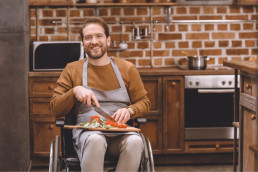A Compilation of Cooking Tips for People with Disabilities
Cooking with a physical disability presents various challenges for any home chef with a mobility impairment or disability. In a post-covid world, for those who are immunocompromised or cutting back on expenditures, eating out is a luxury that many are not able to indulge. From a lack of adaptable utensil and appliance options to poorly designed kitchens, sometimes, the modern-day kitchen can feel like it has somewhat of an agenda against persons with disabilities.
Mobility impairments or limited engagement of cognitive and physical capacity could make even the most enthusiastic kitchen aficionados not fancy their culinary chances. Historically, the prospect of persons with disabilities having a convenient experience in the kitchen is a topic starved of due attention. However, with advances in inclusive design and technology, we can confidently say times have changed.
Innovation and social restructuring in the form of spreading awareness of the importance of empowering people with disabilities have all shown how these perceived problems could be a catalyst to spur our creative capacity for problem-solving. Nowadays, the idea of cooking with a physical disability doesn’t have to feel like running a marathon.
The world wide spread of social awareness and inclusion has led innovations in product and interior design so that anyone can cook with a physical disability.
iAccess life has dug deep to reel out incredibly actionable cooking tips for people with disabilities. Most of these tips have been sourced from chefs & nutritional experts who cook with physical disabilities.
Start your cooking journey with our favorite organic & non-GMO brands, plus guaranteed savings—delivered to your door. Choose a FREE gift, up to $22 value, when you purchase a Thrive Market membership
Your Kitchen Setup
For people with disabilities, success with cooking and your experience in the kitchen can be vastly enhanced by setting up an optimal cooking environment and purchasing the right cooking utensils and appliances.
Lighting:
In an ideal situation, you want to make sure that you have good overhead lighting in the kitchen to start with.
Your Space:
Ideally, your kitchen should have a minimum of 5 x 5 foot radius altogether for flexibility while turning. If you don’t have that much space, you can try to find somewhere else to do prep work, for instance in your living room or dining room.
Kitchen hardware:
As far as your abilities go, Kitchen hardware can be a mismatch sometimes. For instance, you can replace small knobs with pull bars. Whatever you’re changing, just make sure that it suits your ability. Cupboards with slide-out and pull-out drawers can be a great help as well.
Kitchen appliances:
These are equally important because you need appliances that are easy-to-handle, reachable and not very heavy in size. “Easy-to-use access” is the key here.
Countertop height:
For people in a wheelchair, the height of your kitchen tables is something that you might need to pay attention to. If you have the budget, you can lower the kitchen counter to suit your reach. Custom counter and sink heights are a great addition to make a kitchen very adaptive.
If you don’t have the budget, you can also buy a small prep table on wheels that you can use for most of your kitchen work. Appliances that are small in size like your toaster, blender, and your microwave oven should be on a low countertop
Faucets:
Faucets with electronic touch or hands-free functions are preferred for people with disabilities.
As an Amazon Associate, we earn from qualifying purchases.
Adaptive Kitchen Tools
Adaptive Kitchen Tools
There is a legion of tools that exists for people with disabilities. For instance, there are rocker knives and silverware with a built-up handles for those with limited gripping capacity.
Cutting boards:
There are cutting boards with a mini-spear placed just in the center to help keep food in place for slicing.
Single-handed cutting boards with spikes:
This helps to hold food items in one position when chopping them. It averts the all-too-common slip-away when slicing.
As an Amazon Associate, we earn from qualifying purchases.
Pastry Cutter:
If you are not able to use knives due to your disability, then you may be better suited to use a pastry cutter for chopping. While it might not be the sharpest tool in the shed, it gives better angles and precision of movement and doesn’t require as strong of a grip. A worthy trade-off if you ask us.
A Long arm grabber:
It has a clamp at the end working from a handle on the other. These sorts of tools enable people with wheelchairs or those with limited range of movement in their arms to grab objects that are located in higher compartments beyond their reach, and it doesn’t cost much.
A can opener mounted on the wall:
A wall-mounted can opener positioned at the ideal height can make opening cans extremely easy.
As an Amazon Associate, we earn from qualifying purchases.
Cylindrical foams:
If your impairment makes it difficult to get a solid grip on objects with handles, you can always “install” a cylindrical foam to make gripping less stressful.
A small table with some wheels or a Push Cart
This can also serve as a rolling utility cart to help move objects within the kitchen or the dining table.
Disposable Gloves:
A little extra-caution never hurt anyone. In fact, in this post-covid world, it is very important to wear gloves to prevent contact between your food and other potential transmitters of pathogens & germs.
As an Amazon Associate, we earn from qualifying purchases.
Cooking strategy
As the old cliché goes, when you fail to plan, you plan to fail.
Having a well-considered strategy can be the best of all the cooking tips for the disabled. Tips like leaving large amounts of cooking for days when you have a lot of help in your corner, putting things in place to avoid accidents like a broken jug, careful planning of your recipe so that you are not missing any ingredients—all of these can make your cooking a hitch-free experience if done correctly, or a stint to forget if done wrong.
Time management:
This is a very important skill in the kitchen, and out of it as well. You don’t want to spend time going through the motions on tasks that should not be top of your cooking agenda. Space your tasks, and take breaks when needed.
Even though you might be your boss when it comes to ruling the kitchen, a little helping hand never hurts anyone—you are better off scheduling your time to coincide when your loved ones would be available to help out.
Keep that repertoire to the minimum:
Being as minimalistic as possible when using utensils can benefit you in many ways. You can access them better and that your kitchen utensils/tools become predictable when you try to locate them, which can only be a good thing. The same ingredients and same tools mean you’re not using what you don’t need, so there’s not a lot of clutter in the way of your swift cooking. Remember, cooking with a physical disability can sometimes be all about your ability to cut through the noise.
Take the occasional “chill-pill”:
From power naps to the odd self-imposed retreat in between cooking sessions, fatigue can be a real issue to deal with—and that’s perfectly normal. So, you might want to keep a relaxation chair nearby should you have the need to take a break (or two.)
Trust the process:
Paying attention to the substance of your cooking and not the form can be a refreshingly rewarding exercise. It does not matter if you are not able to cut a perfect slice or cook a 5-star restaurant quality meal. What matters is that you’re applying yourself to the experience of using your senses despite your perceived limitations—and that is something you should be grateful for.
So, don’t be too hard on yourself. Breathe.
Support from loved ones
Cooking with a physical disability requires a handful of support from friends and family, and they can always manifest this support in these two ways:
Give them Autonomy:
It can be a pretty tempting to insist on offering to help out people with disabilities. This may seem counter-intuitive, but you’re actually not helping them when you do that. However noble your intention may be, “attempting to rob” people with disabilities of their autonomy in the kitchen bashes their confidence.
Empowerment:
You’ve got to give people with disabilities a seat at the table when it comes to any day to day chore, including cooking. Invite them, not to “tick an inclusivity box,” but as a welcome addition to the already existing kitchen workforce. It could be as simple as giving them little tasks, like measuring ingredients, that make them feel like they are part of the process.
Conclusion
For those with disabilities, cooking might not be the easiest job, but it’s not the hardest either. Remember, a lot of people with disabilities have cooking as an actual hobby and some may even cook professionally.
Try not to think of it as a chore. Instead, think of it this way—a fun-to-do activity that engages your creative capacity to solve orthodox problems through rather unorthodox solutions—and you’re solid!
Cooking with a physical disability is a never-ending, solution-finding puzzle that you will have to figure out for yourself—and for most disabled people, that’s the thrill of it. Revel in it.
Finally, while these cooking tips may be intended for disabled persons, most of the tips and suggestions here pretty much work for anybody. These cooking tips for people with disabilities should have you whipping your way into culinary Nirvana in no time!




